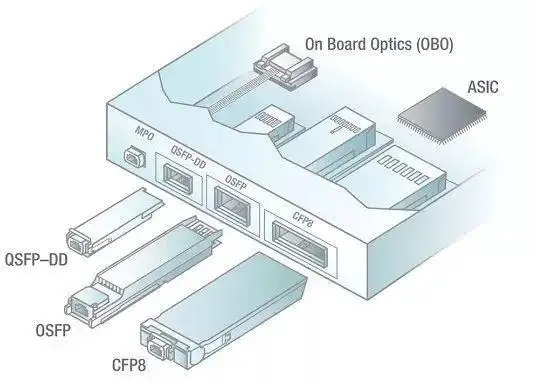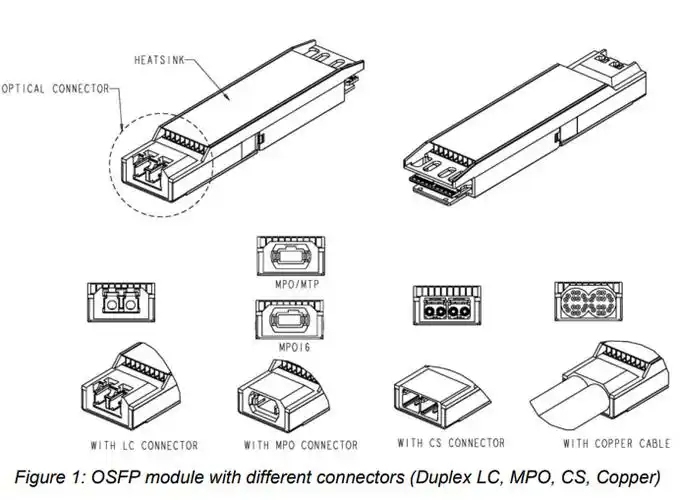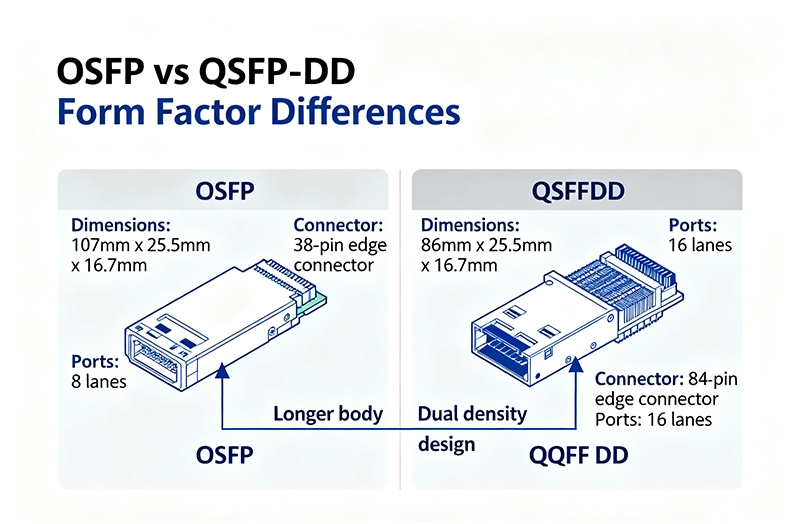How to Understand OSFP vs QSFP-DD Form Factors

Deciding between OSFP and QSFP-DD form factors holds tremendous strategic significance as it relates to the evolution of network infrastructure. The choice made will impact not only system performance and efficiency with cost in mind, but will also influence compatibility and interoperability with existing technology. Choosing the right data center optical module has a bearing on how any upgrade will impact the capacity and constraints to increase bandwidth while managing power and thermal issues.
Understanding how the OSFP and QSFP-DD differ provides an understanding of alignment between commitments to technology and operating objectives related to that technology. Each data center optical module demonstrates its own characteristic physical and electrical philosophies. The compatibility of each of the two form factors discusses density of deployment (or form factor density) with the thermal management particular to each module. Getting a clear picture of both form factors of data center optical modules will save time and resources by avoiding some of the effects of costly assumptions and is ultimately necessary to make informed judgments about upgrades for a network that will last into the future.
This introduction promises a thorough, data-supported analysis of OSFP vs QSFP-DD. A reader should expect to learn about technical differences, maturity of the ecosystem, and trends. Armed with that knowledge, a reader can make policy decisions and upgrades to the network that allow for value and extensibility.
What are the Physical Design Philosophies of OSFP and QSFP-DD?
The OSFP design focus is on power efficiency and thermal management, within a greater physical footprint. At approximately 14 mm wider and deeper than QSFP-DD, the OSFP design allocates more space to move air and a larger surface area to be used with integrated heat sinks for heat dissipation. This design approach also allows for higher power budgets, which are essential to support emerging data rates exceeding 400G. (Think of OSFP less as a “one-room” structure, but more as a “two-room” apartment or a room that has more ventilation design to cool your devices during heavy workloads.)
The QSFP-DD design focus is on compact size and backward compatibility. The QSFP-DD size is approximately identical to the size of the popular QSFP family, at 18 mm wide, which allows it to simply replace other network hardware. Now, the “double density” designation refers to the use of two rows of electrical contacts, so you have double the same number of data lanes without a significant increase in physical width. The size also supports higher port counts on switch panels, but with the cost of less surface area; therefore, a thermal solution must be designed into the equipment due to the decrease in space. (Think of QSFP-DD more as a small high-rise apartment; it efficiently places more connections in less space, but must have a plan for thermal remediation.)
From an architectural perspective, OSFP incorporates 8 lanes of electrical interface specifically designed for 50G PAM4 signal types, with an emphasis on straightforward signal integrity and lane power consumption. The socket is designed to accommodate a taller pluggable module, thus increasing the thermal cure and enabling larger heatsinks to adequately cool the internal components. Comparatively, the QSFP-DD format can be implemented in either an 8-lane (50G) or 4x100G configuration with PAM4 modulation, designed for flexibility so it can better fit into tighter shells and support high-speed optical output. The compact form factor of the QSFP-DD module must carefully account for the extremely high electrical performance demands placed on the heatsinking capabilities, making planning for heat buildup absolutely critical in any form factor in a smaller package.
These differing physical designs result from different trade-offs: simplicity of coolability and power scale with OSFP, versus a dense deployment for use outside the traditional box while maintaining some fast ecosystem support with QSFP-DD. To determine which to use, ask yourself: will it be more beneficial for your data center optical module to use space or consider thermal capacity first?
To briefly summarize the key differences:
- Form factor: OSFP has a larger form factor, which can accommodate more cooling; QSFP-DD is more compact to interface with a higher density on the panel.
- Thermal design: OSFP thermal design potentially uses a larger heatsink more naturally; QSFP-DD uses advanced material thermal management or airflow from switches to cool smaller heatsink designs.
- Electrical layout: OSFP potentially supports 8 lanes of 50G PAM4; QSFP-DD supports either an 8-lane or a 4x100G lane mode of PAM4 modulation.
- Combo capability: The QSFP-DD compatible design incorporates arrayed backwards-compatible designs; the OSFP design takes an entirely new approach for the future.
Understanding the difference, network architects will carefully choose the form factor to align performance requirements and usage or deployment environments to choose the best data center optical module.

How Do Size and Thermal Management Impact High-Density Deployments?
The size and thermal considerations of OSFP and QSFP-DD are key determinants of their suitability for high-density use cases. Since OSFP modules are larger and around 14 mm wider and deeper, OSFP modules can support larger heat sinks, enabling more effective thermal dissipation capability. This design enables OSFP modules to handle higher power with less likelihood of performance degradation, which is part of the requirement for data centers with a strict cooling strategy. On the other hand, QSFP-DD, being the smaller of the two, will support a denser layout of ports on network panels as the dimension of the QSFP-DD module is very close to that of legacy QSFP modules. Therefore, any racks or modules that have legacy QSFP as a design standard will experience an increase in connectivity due to the diminutive dimension of QSFP-DD. However, similarly to OSFP, the smaller size of QSFP-DD also dissipates somewhat less thermal energy onto the heat sink due to the smaller surface area, and thus, relies on newer material thermal conductivity and effective airflow to maintain thermal performance of the QSFP-DD modules. Depending on the cooling strategy, while OSFP is designed with the expectation of heat dissipation based on size, QSFP-DD may require additional cooling infrastructure in very dense network environments.
The choice between size and thermal capability shapes deployment choices. The OSFP’s larger chassis favors deployment in environments where the designer believes cooling capacity is limited or areas where there are concerns with power per port. The QSFP-DD is a high-density port count. Connectors and modules reflect high-density design goals; however, they may not optimize adjacent modules or designs for ventilation or airflow. QSFP-DD may allow more ports in a relatively small space, but it may cost more on a monthly basis for operational cooling costs.
When comparing panel density and depth, QSFP-DD enables about twenty-five percent more ports than OSFP in the same rack space. The net gain from the QSFP-DD can reduce a network upgrade cycle, but some consideration of thermal planning is necessary, as time may be spent mitigating hotspot generation. Although OSFP takes up more space in a rack and cabinet, it is also less congested, with fewer networking ports and modules, and it provides a more predictable heat dissipation pattern and a better cooling capability that can be integrated with existing rack-installed cooling.
Summary:
- OSFP size: Larger size and dimensions allow for enhancements of heat sinks and larger thermal dissipation.
- QSFP-DD thermal management: Reduced size needs increased airflow and materials to alleviate overheating.
- High-density deployment: QSFP-DD provides greater port density; OSFP provides more thermal headroom.
- Cooling Impact: A rack full of OSFP modules reduces cooling complexity and costs drastically; a rack of QSFP-DD modules may increase power and cooling complex designs.
Thoughtfully balancing these variables, network designers should prioritize thermal resilience based on deployment origin or choice, or they should prioritize spacing uses, again, based on deployment choices. The tricky part is to visually compare recommendations for cooling type, water cooling, air balance, tower cooling, and supporting the data center with vendor cooling capacity, providing the most efficient, still usable, planned, and executed thermal designs.
What Electrical Interfaces Define OSFP and QSFP-DD Performance?
The OSFP electrical interface uses a typical 8-lane design where each lane carries 50G signals using PAM4 modulation. This transmission recognizes the benefit of separating the data into smaller physical connections, therefore creating multiple paths where the data is evenly distributed. This design simplifies the signal path, which reduces interference and leads to a more reliable signal. To describe it simply, think of it as a multi-lane highway where each lane carries continuous traffic, creating less congestion and smoother movement.
The QSFP-DD electrical interface has specific capabilities with its electrical options. Choose between 8 lanes which still carry 50G PAM4, or 4 lanes that carry 100G PAM4. This presents different solutions for different network needs, either accepting a larger number of lanes with a known capability or a maximum 400G throughput condition using fewer lanes. PAM4 modulation doubles the number of bits per signal cycle by using 4 different amplitude levels to encode the data. While improving bandwidth, it relies upon an error mitigation mechanism capable of maintaining the integrity of the signals sent.
The relationship between power consumption and these interfaces is evident. OSFP’s design utilizes dedicated lanes with moderate speeds and a lower power per lane, while QSFP-DD’s increased signaling density at higher data rates consumes higher values of power and, as a result, increases the need for thermal solutions. When assessing modules, power and cost must be balanced with the objective of performance improvements.
Key insights about electrical interface:
- OSFP electrical interface: 8x50G lanes with PAM4 – simpler signal management with lower energy consumption.
- QSFP-DD PAM4: ability to support 8 lanes at 50G or 4 lanes at 100G, providing flexibility and bandwidth as a package.
- PMD technology: both utilize PAM to increase transmission rates without adding another frequency.
- Provide power and signal integrity: OSFP is designed to be lower power with stable lower power lanes. QSFP-DD requires additional error correction to optimize quality.
Ultimately, the differences provide strategic decisions regarding data throughput, power efficiency, and signal fidelity. The choice of electrical interfaces can affect your ability to scale a network and operating costs when migrating to next-generation DCO modules.

Why Does Ecosystem Compatibility Affect Cost and Adoption?
The compatibility of hardware with the ecosystem is important for both the cost and speed of adopting OSFP and QSFP-DD form factors. QSFP-DD has significant backward compatibility with existing QSFP modules, which is a design decision that permits users to plug QSFP-DD modules into their existing deployment and avoid costly wholesale upgrades, while simplifying the network migration process. OSFP has a newer physical interface with limited backward compatibility, therefore requiring hardware upgrades due to its larger size and connector type, typically resulting in increased cost for deployment. While OSFP can provide thermal and power benefits, the required hardware upgrades to switches and adapters could hinder adoption rates in more established data centers.
The maturity of the ecosystem also impacts cost efficiency. QSFP-DD is widely supported by numerous vendors with an established supply chain, which leads to lower prices and availability of modules. Although the ecosystem for OSFP is growing, it is still a niche option. There are limited vendors and a less mature scale of manufacturing, which leads to higher prices and longer lead times.
The compatibility and cost considerations can be summarized as follows:
- Backward compatibility of QSFP-DD: this provides for a smoother migration of networks and less incremental upgrade costs.
- The cost to deploy OSFP is higher due to the requirement for new hardware and minimal reuse of existing infrastructure.
- Ecosystem maturity: QSFP-DD has an established ecosystem of diverse vendors, and OSFP is still growing in market presence.
- The speed of adoption is faster using QSFP-DD where cost-sensitive upgrades tend to dominate; OSFP is most appropriate for environments focused on performance improvement over initial dollars spent.
Understanding these factors will assist decision makers in rapidly assessing total cost of ownership. Prior to selecting a form factor, evaluate options based on the existing infrastructure, vendor relationships, and migration strategy to ensure the investment will provide the most value in the future.
How Does Power Consumption and Heat Dissipation Impact Data Center Operations?
Power consumption and heat dissipation are vital factors in data center operations, both impacting infrastructure costs, reliability, and availability of the systems. Real-world thermal performance testing has shown some unique characteristics of the OSFP and QSFP-DD modules, which will influence the power and cooling strategy for rack systems.
The OSFP measured power consumption was in the typical range of 12 watts to 18 watts of power consumed from each optical module per 100G connection. The larger design of the OSFP helps with a larger heat sink and thermal performance. A lower temperature of operation is also a thermal benefit, resulting in less demand for extreme cooling in the data center and an overall decreased demand on the data center HVAC load. The OSFP has a lower junction temperature, resulting in better module life expectancy and improved performance in peak system workloads.
In comparison, QSFP-DD modules utilize approximately 15 to 20 watts for the same data rates but do not afford as much die space for heat dissipation, meaning the heat results in higher surface temperatures. This means that data center operators must accommodate localized hot spots by increasing airflow or by utilizing advanced coolant systems (i.e., liquid cooling). Although QSFP-DD allows for increased port density, the thermal characteristics and heat dissipation properties impose greater demands on the cooling infrastructure overall.
Thermal test takeaways should consider:
- OSFP power usage—significantly lower and more consistent power usage leads to reduced cooling overhead.
- QSFP-DD heat dissipation—concentrated heat should be managed with special airflow methods and designs.
- Rack power usage—OSFP racks are able to run with normal cooling; however, QSFP-DD often has racks that require specialized systems to cool the heat generated.
- Operating efficiency—thermal characteristics have a dramatic impact on the ability to drive workload performance changes or implement systems maintenance.
When all things are considered upfront, this process will help a network operator avoid excess spending on expensive power overprovisioning. When you can identify accurate models for both power and thermal loads, the design of your overall cooling systems and the total amount of cooling system capacity needed will be straightforward. Addressing the cooling capabilities of the specific operational facilities is important when selecting from OSFP or QSFP-DD modules, especially if optimizing operational costs quickly is desired while preserving hardware longevity.
In conclusion, broadband access between OSFP and QSFP-DD systems is measured in the performance level per watt of power usage. However, the choice is much more complicated than raw performance, because the realistic capabilities of power and heat management must be both preventatively and proactively accommodated when deploying in dense data center environments.

What Industry Trends Are Shaping the Future of Data Center Optical Modules?
As trends emerge within data center upgrades, optical modules offering higher speed, power efficiency, and scalability are becoming increasingly prevalent. OSFP and QSFP-DD are two segments fueling this evolution, developing along separate pathways aligned with market demand. Understanding their future paths can provide insight into future capital expenditure payback durations.
OSFP market growth demonstrates a demand for scalability and improved thermal management. The larger form factor supports increased power demands for emerging 800G and even terabit-class modules. The adoption of OSFP typically takes place in environments where space density is less of a concern compared with sufficient cooling and operational stability. The OSFP form factor’s growing ecosystem indicates its increased importance for next-generation or high-performance deployments.
The future of QSFP-DD centers on maximizing port density and ecosystem compatibility. The form factor benefits from backward compatibility with existing QSFP modules. This allows for upgrades within existing networks with minimal disruption to service. The QSFP-DD form factor’s development of new associated components for both 400G and 800G speeds caters to the pace at which data centers at the core of these evolving environments are willing to adapt for improved space density and greater increment of service. QSFP-DD will continue to substantiate its presence for both hyperscale and enterprise environments, where existing networking needs determine they require compact, powerful networking solutions.
Highlighted the trends in the industry:
- Trends in data center upgrades: speed, power efficiency, and scalability
- OSFP market growth: thermal benefits and high-capacity options
- QSFP-DD future: forward-looking compatibility, density, and gradual adoption
- Adoption trends: OSFP for thermal-sensitive installations, QSFP-DD for networks and data centers with space constraints
When patterns are understood, the infrastructure strategy can align module selection with long-term architecture. The two form factors will coexist as there are needs across many segments in the industry. Decision makers will be guided by tracking the vendor roadmap and ecosystem development within the data center optical module technology.
How Did a Leading Data Center Choose Between OSFP and QSFP-DD?
A prominent hyperscale data center recently encountered a challenging decision-making process choosing between OSFP and QSFP-DD modules for the upgrade of an existing network in the data center to 400G. The team’s main focus was on a solution that would meet future network growth requirements with power constraints while on a budget.
The analysis resulted in QSFP-DD interoperability and backward compatibility with existing QSFP technologies, with a gradual introduction that would ease operability within the network. The compact form factor facilitated port density for value in dense rack environments, but thermal management mitigation for cooling was a concern, as the new module had a reduced footprint.
On the other hand, OSFP adoption boasts superior thermal performance (lower power per lane and greater heat transfer) and would be a great first step in capitalizing on operational stability in high-performance and power-intensive scenarios. However, costs for any potential hardware retrofitting and the requirement of new switch architectures increased initial costs, resulting in an analysis of total cost versus benefits.
In the end, a hybrid decision was made. QSFP-DD modules were pulled in to address immediate capacity needs, with very little risk in terms of the migration aspect. In the future, OSFP would be designed for high-density, high-power, and power-aware segments of the network that would go with robust thermal designs. This strategic layering took advantage of an increasing share of the QSFP-DD market for quick wins, while allowing space for scaling OSFP for longer-run growth.
Takeaways from the case study:
- Network migration – QSFP-DD enabled the smooth transition by making the earlier models backward compatible.
- Thermal and power – OSFP had a thermal advantage and was much more efficient in power management.
- Cost – OSFP had a higher initial upfront cost due to something new being introduced into the hardware.
- Layered approach – Both form factors employed allowed for the best of both worlds by achieving performance with price constraints.
As this example demonstrates, data centers are able to reconcile competing factors by utilizing OSFP and QSFP-DD for specific segments of the network. This is a real-world example of making decisions in a real-world context and provides a potential model for others facing a similar challenge or upgrade of their own network.

How to Smoothly Transition Between OSFP and QSFP-DD Form Factors?
While switching between OSFP and QSFP-DD form factors can be daunting, it’s not entirely impossible if you plan ahead and use adapters. An OSFP to QSFP adapter acts as a translator, making it completely seamless to connect your OSFP module to a QSFP-DD port. This increases continuity during phased upgrades and ultimately means systems do not need to be completely replaced.
Adapters help keep networks online by bridging both the physical and electrical differences in form factors, but they do not compromise any of the signal integrity during that transition. The result is that data centers can slowly adopt the thermal characteristics of OSFP while keeping the advantages of density that QSFP-DD offers in the meantime. The reality is that many organizations experience either a constraint in their budgets or their operations simply won’t allow them to replace all their hardware or operate multiple types of hardware.
When preparing a network transition plan between form factors, consideration needs to be given to compatibility testing, thermal testing, and available power budgets. Being even slightly prepared with your infrastructure to engage in a mixed-form factor environment will only minimize disruptions. Additionally, staging deployments with adapters allows environments to assess their real-world performance before fully committing to one form factor.
Transitioning made easy:
- Adapter compatibility—allows physical and electrical compatibility across form factors.
- Migration plan—phased transitioning reduces risk and provides flexibility with timing investments.
- Infrastructure—ensure cooling and power readiness for hybrid deployments.
- Performance validation—continually validate data integrity and assess the thermal impact of both form factors.
A well-prepared transition plan with OSFP to QSFP adapters performs an orderly migration toward the next-gen network path while ensuring current network operations and investments are safe.
Conclusion
Ultimately, the choice between OSFP or QSFP-DD is a preference based on your particular network requirements versus looking for a “better” alternative. Each card has its own merits: OSFP has a better thermal profile and better power utilization, while QSFP-DD is a compact form factor with backward compatibility. Each decision maker should consider deployment density, cooling limitations, power budget, and the migration plan for the network when making these decisions. Data-driven analytical assessment and case studies will show you how both forms can be used harmoniously to obtain an optimum performance-to-cost ratio.
In the end, educated decisions about form factors come from an understanding of the technological differences between form factors, the operational impact on the customer’s data center journey, and the maturity of the ecosystem for each form factor. An educated form factor selection contributes to long-term transport network requirements and provides a lower cost of ownership when planning for future scalability for data center requirements.
Reference Sources
- AscentOptics – Comparison of QSFP-DD with Other Optical Modules: In-depth overview of QSFP-DD and OSFP optical transceiver differences, including form factors and electrical specs. Source
- FiberMall – 400G QSFP-DD vs OSFP vs QSFP56: Comprehensive technical analysis of 400G module form factors, scaling, power, and cooling considerations. Source
- QSFPtek – 800G Transceivers: QSFP-DD vs OSFP, Which to Choose?: Discusses the strategic use cases, ecosystem maturity, and deployment strategies for QSFP-DD and OSFP modules. Source
- Walsun – Difference between 800G QSFP-DD and OSFP: Details design differences, thermal management, and power consumption metrics. Source
- Fibers and Networks – Differences Between QSFP-DD and QSFP+: Technical distinctions of QSFP-DD, OSFP, and related optical form factors for network scalability. Source
